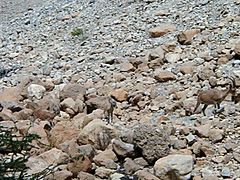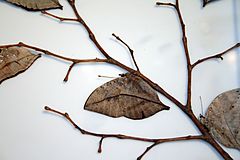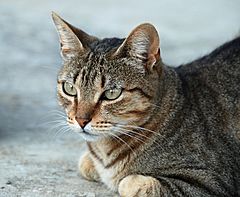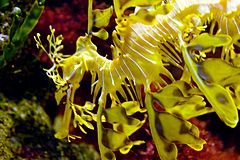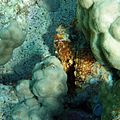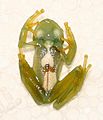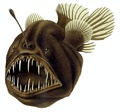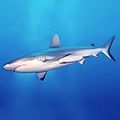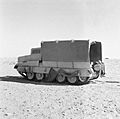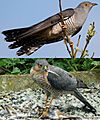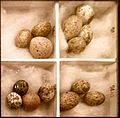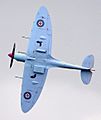Camouflage facts for kids

Camouflage is a visual disguise. Without it, an animal would be recognised easily. If the natural colour of an animal makes it look like its surroundings, that is camouflage. A tiger's stripes in the long grass, and the battledress of a modern soldier are examples.
Camouflage is a form of deception. The word camouflage comes from the French word camoufler, which means "to disguise".
Contents
Natural camouflage
In nature, most animals blend into their environment or conceal their shape. They are very hard to see. This way they survive, and if they survive, then they can reproduce. There are exceptions: animals which are dangerous to eat (e.g. wasps) advertise with warning colouration.
Prey animals hide from predators. Predators must search for prey without being seen. Natural camouflage is one way to do this: an animal can blend in with its surroundings. Another way is for the animal to disguise itself as something harmless.
Some camouflaged animals also copy movements in nature, e.g., of a leaf blowing in the wind. Other animals attach natural materials to their body for concealment. A few animals change color in changing environments. Seasonally: (many Arctic animals, such as the arctic fox, or arctic hare). Or quickly, like the chameleon and the cuttlefish. Some herd animals, like zebra, have a pattern which makes it difficult for the predator when they are running.
Mimicry is a special kind of camouflage, where an animal or plant looks like another, usually one which is unpleasant to eat or dangerous.
Countershading
Most animals are dark on top and light underneath. With light coming from the sky, this countershading makes them less visible. That this is the correct explanation is proved by cases where the animal lives upside down. A famous example is the Nile catfish, which swims belly uppermost. In this case, the belly is dark, and the back is light in colour.p43
Transparency and silvering
Transparent or partly transparent animals are common in the pelagic layer of the sea. These are the layers into which light penetrates. The effect of transparency or silvering works is better under water than above it. This is because the amount of light which penetrates is less and less as the depth increases. Also, the proportion of the light reflected is much less under water (0.001–0.6%) than in air (2–5%).
Related pages
- Military camouflage
- Mimicry
- Warning colouration: the opposite of camouflage
- Ferrari, Mareo 1992. Colors for survival: mimicry and camouflage in nature. NY: Barnes & Noble. ISBN: 0-7607-0551-8
- Behrens, Roy R. 2002. False colors: art, design and modern camouflage. Bobolink Books. ISBN: 0-9713244-0-9
- Wolf, Art 2005. Vanishing act. Text by Barbara Sleeper. NY: Bullfinch Press. ISBN: 0-8212-5750-1
- Purser, Bruce 2003. Jungle bugs: masters of camouflage & mimicry. Toronto: Firefly. ISBN: 1-55297-663-7
- Forbes, Peter 2009. Dazzled and deceived: mimicry and camouflage. Yale University Press. ISBN: 978-0-300-17896-8
- Harris, Tom. 2006. How animal camouflage works. [1] How Stuff Works.
- BBC/Attenborough: Octopus hides in shells, from Blue Planet II. [2]
Gallery
-
A mantis from Madagascar looks like a dead leaf.
-
Two flatfish blending in!
-
A leaf insect at home
-
Zoo tiger looks striking: but in home environment it blends with the long grass.
-
Tawny Frogmouths blend in with colour and texture of tree bark. Sydney, New South Wales, Australia
-
Draco indochinensis uses several methods of camouflage: disruptive colouration, lying flat, concealment of shadow.
Images for kids
-
The peacock flounder can change its pattern and colours to match its environment.
-
Octopuses like this Octopus cyanea can change colour (and shape) for camouflage
-
Abbott Thayer's 1907 painting Peacock in the Woods depicted a peacock as if it were camouflaged.
-
The leafy sea dragon sways like seaweeds to reinforce its camouflage.
-
Principle of counter-illumination in the firefly squid
-
Many animals of the open sea, like this Aurelia labiata jellyfish, are largely transparent.
-
Glass frogs like Hyalinobatrachium uranoscopum use partial transparency for camouflage in the dim light of the rainforest.
-
The adult herring, Clupea harengus, is a typical silvered fish of medium depths, camouflaged by reflection.
-
Blackdevil anglerfish is one of several deep-sea fishes camouflaged against very dark water with a black dermis.
-
The zebra's bold pattern may induce motion dazzle in observers
-
Roman ships, depicted on a 3rd-century AD sarcophagus
-
Green-jacketed rifleman firing Baker rifle 1803
-
Iron observation post camouflaged as a tree by Cubist painter André Mare, 1916
-
Egyptian nightjar nests in open sand with only its camouflaged plumage to protect it.
-
Papuan frogmouth resembles a broken branch.
-
Bright green katydid has the colour of fresh vegetation.
-
Jumping spider: a disruptively camouflaged invertebrate predator
-
The flat-tail horned lizard's body is flattened and fringed to minimise its shadow.
-
Sniper in a Ghillie suit with plant materials
-
Male Australian Emperor dragonflies use motion camouflage to approach rivals.
-
Norwegian volunteer soldiers in Winter War, 1940, with white camouflage overalls over their uniforms
-
Veiled chameleon, Chamaeleo calyptratus, changes colour mainly in relation to mood and for signalling.
-
Countershaded Dorcas gazelle, Gazella dorcas
-
Countershaded grey reef shark, Carcharhinus amblyrhynchos
-
Countershaded Focke-Wulf Fw 190D-9
-
Peppered moth caterpillars mimic twigs
-
This grasshopper hides from predators by mimicking a dry leaf
-
Armed WW1 Q-ship lured enemy submarines by mimicking a merchantman
-
Cuckoo adult mimics sparrowhawk, giving female time to lay eggs parasitically
-
Cuckoo eggs mimicking smaller eggs, in this case of reed warbler
-
A Spitfire's underside 'azure' paint scheme, meant to hide it against the sky
-
A Luftwaffe aircraft hangar built to resemble a street of village houses, Belgium, 1944
-
Red Army soldiers in the Battle of Stalingrad in snow camouflage overalls, January 1943
-
British Disruptive Pattern Material, issued to special forces in 1963 and universally by 1968
-
US "Chocolate Chip" Six-Color Desert Pattern developed in 1962, widely used in Gulf War
-
André Mare's Cubist sketch, c. 1917, of a 280 calibre gun illustrates the interplay of art and war, as artists like Mare contributed their skills as wartime camoufleurs.
-
Camouflage clothing in an anti-war protest, 1971
See also
 In Spanish: Camuflaje para niños
In Spanish: Camuflaje para niños


